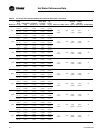
UH-SVX01A-EN 55
Periodic Service
ƽWARNING
Hazardous Voltage
Open all disconnect switches and
secure in that position before
servicing unit. Failure to do so may
result in personal injury or death
from electrical shock.
ƽCAUTION
Rotating Components
Allow rotating fans to stop before
servicing to avoid serious injury to
fingers and hands.
Because of the simple design of the
steam and hot water unit heaters,
they are nearly maintenance free.
However, depending on the
environment, simple maintenance
practices should be adopted.
Periodically check the finned
surfaces and vacuum these as often
as necessary to remove any
accumulation of lint and dirt. Check
fan blades and remove dirt
accumulation. If fan blades are not
cleaned they tend to become
unbalanced.
Most of the motors supplied on the
unit heaters have either ball bearings
or sleeve bearings and should not
require lubrication for long periods
of time. It is however advisable that
motor maintenance and lubrication
recommended by the motor
manufacturer be followed.
Check motors for dirt and dust
accumulation, and remove any
accumulation as often as necessary.
Open type motors may overheat if
the dirt or dust is not removed from
ventilation openings.
Motor Lubrication
Sleeve Bearings
Motors with oilers or oil holes are
lubricated before shipment with a
good grade of electric motor oil.
Refill when necessary, with the
motor at a stand-still, until oil
reaches the proper level.
Use SAE 20W non detergent oil for
motors operatingin ambient
temperatures of 32°F to 100°F (0°C to
38°C). Below 32°F (0°C), SAE 10W
non detergent oil will be required.
The frequency of oiling will depend
upon operating conditions and
length of running time. Inspect the
oilers or oil holes when cleaning the
unit. If the unit has a fractional
horse-power motor, lubricate at least
once a year. Under high ambient
conditions or constant fan operation,
fractional horse-power motors
should be lubricated every 90 days.
On those motors without oilers or oil
holes, follow the instructions given
on the motor nameplate.
Ball Bearings
Ball bearing motors are pre-
lubricated and normally not
equipped with grease fittings.
However, motors are equipped with
removable grease plugs to allow
installation of grease fittings if
desired by owner. Motor
manufacturers do not recommend or
require on the job lubrication of ball
bearing motors.
If on the job lubrication is required
by the owner, use the following
procedure: With the motor at a
stand-still, remove the vent and
grease plugs. Install grease fitting
and add grease sparingly. Remove
the old grease from the vent relief
chamber. Operate the motor a few
minutes before reinstalling the vent
plug to allow excess grease to
escape. If there is evidence of grease
working out around the motor shaft,
less grease should be added and the
greasing periods lengthened. If
grease continues to appear, take the
motor to the motor manufacturer’s
authorized service station for repair.
Note: Consult local motor
manufacturer’s service
facility for information on
type of grease and oil to be
used.
Note: The heater system should be
checked once a year by a
qualified technician. All
maintenance/service
information should be
recorded accordingly on the
inspection sheet provided in
this manual.
Should maintenance be required,
perform the following inspection and
service routine:
Inspect the area near the unit to be
sure that there is no combustible
material located within the minimum
clearance requirements listed in this
manual.
Cleaning the Unit
The unit casing, fan, diffuser and coil
should be cleaned thoroughly once a
year. Coil heat transfer efficiency
depends on cleanliness. The
following recommended procedures
may be performed when lubricating
the motor and cleaning the coil.
1. Wipe all excess lubricant from
the motor, fan and casing. Clean
the motor thoroughly. A dirty
motor will run hot and
eventually cause internal
damage.
2. Clean the coil:
a. Loosen the dirt with a brush
on the fan side of the coil.
Operate the motor allowing
the fan to blow the loosened
dirt through the unit.
b. Use high pressure air or
steam on the side of the coil
away from the fan.
Note: A piece of cheesecloth or
a burlap bag may be
used to collect the large
particles during the
cleaning process.
3. Clean the casing, fan blades, fan
guard and diffuser using a damp
cloth. Any rust spots on the
casing should be cleaned and
repainted.
4. Tighten the fan guard, motor
frame and fan bolts. Check the
fan for clearance in the panel
orifice and free rotation.
Maintenance


















